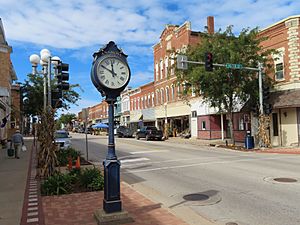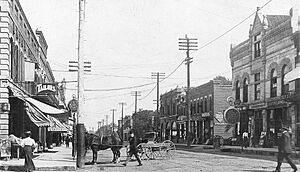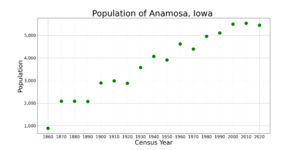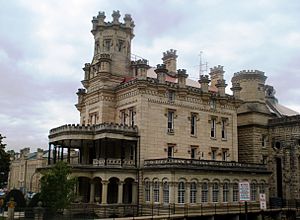Anamosa, Iowa facts for kids
Quick facts for kids
Anamosa, Iowa
|
||
|---|---|---|

Anamosa, 2021
|
||
|
||
| Nickname(s):
A-Town
|
||

Location of Anamosa, Iowa
|
||
| Country | ||
| State | ||
| County | Jones | |
| Area | ||
| • Total | 2.53 sq mi (6.56 km2) | |
| • Land | 2.52 sq mi (6.54 km2) | |
| • Water | 0.01 sq mi (0.02 km2) | |
| Elevation | 830 ft (253 m) | |
| Population
(2020)
|
||
| • Total | 5,450 | |
| • Density | 2,159.27/sq mi (833.72/km2) | |
| Time zone | UTC-6 (Central (CST)) | |
| • Summer (DST) | UTC-5 (CDT) | |
| ZIP code |
52205
|
|
| Area code(s) | 319 | |
| FIPS code | 19-01990 | |
| GNIS feature ID | 0454176 | |
Anamosa is a city in Jones County, Iowa, United States. The population was 5,450 at the 2020 census. It is the county seat of Jones County.
Contents
History
What is now Anamosa was founded as the settlement of Buffalo Forks in 1838 and incorporated as Lexington in 1856. Lexington was a popular name for towns at that time, so when Lexington chose to become incorporated as a city in 1877, the name was changed to Anamosa to avoid mail delivery confusion. There are many stories on how Anamosa was chosen as a name. Some believe it was named for a local Native American girl named Anamosa, meaning "white fawn", while others say it means "You walk with me."
The romantic origin of the naming of the town of Anamosa comes from its early history. A Native American family was passing through town in 1842. The family stayed at the Ford House. The Native American girl, named Anamosa, endeared herself to the townspeople and following the family's departure from town, local citizens decided to name their town after her.
The Wapsipinicon River flows through Anamosa. According to legend, a Native American maiden and her lover threw themselves off a bluff overlooking the Wapsipinicon River; one was named Wapsi, the other Pinicon. Origins of this legend are unconfirmed.
Anamosa was named the Pumpkin Capital of Iowa by the Iowa State Legislature in 1993 and hosts Pumpkinfest, a pumpkin festival and weigh-off, each October.
The Anamosa Boot Hill Cemetery is still open today and is northwest of the town.
Geography
Anamosa's longitude and latitude coordinates in decimal form are 42.108954, -91.281476. According to the United States Census Bureau, the city has a total area of 2.61 square miles (6.76 km2), of which 2.60 square miles (6.73 km2) is land and 0.01 square miles (0.03 km2) is water.
The Wapsipinicon River flows through the city of Anamosa. Anamosa is served by U.S. Route 151 and Iowa Highway 64.
Demographics
| Historical population | |||
|---|---|---|---|
| Census | Pop. | %± | |
| 1860 | 889 | — | |
| 1870 | 2,083 | 134.3% | |
| 1880 | 2,083 | 0.0% | |
| 1890 | 2,078 | −0.2% | |
| 1900 | 2,891 | 39.1% | |
| 1910 | 2,983 | 3.2% | |
| 1920 | 2,881 | −3.4% | |
| 1930 | 3,579 | 24.2% | |
| 1940 | 4,069 | 13.7% | |
| 1950 | 3,910 | −3.9% | |
| 1960 | 4,616 | 18.1% | |
| 1970 | 4,389 | −4.9% | |
| 1980 | 4,958 | 13.0% | |
| 1990 | 5,100 | 2.9% | |
| 2000 | 5,494 | 7.7% | |
| 2010 | 5,533 | 0.7% | |
| 2020 | 5,450 | −1.5% | |
| U.S. Decennial Census | |||
Anamosa is part of the Cedar Rapids, Iowa Metropolitan Statistical Area.
2010 census
As of the census of 2010, there were 5,533 people, 1,941 households, and 1,163 families residing in the city. The population density was 2,128.1 inhabitants per square mile (821.7/km2). There were 2,105 housing units at an average density of 809.6 per square mile (312.6/km2). The racial makeup of the city was 91.1% White, 6.4% African American, 0.4% Native American, 0.7% Asian, 0.4% from other races, and 0.9% from two or more races. Hispanic or Latino of any race were 2.0% of the population.
There were 1,941 households, of which 30.1% had children under the age of 18 living with them, 41.4% were married couples living together, 13.4% had a female householder with no husband present, 5.2% had a male householder with no wife present, and 40.1% were non-families. 34.5% of all households were made up of individuals, and 17.1% had someone living alone who was 65 years of age or older. The average household size was 2.25 and the average family size was 2.87.
The median age in the city was 39.6 years. 19.6% of residents were under the age of 18; 8.8% were between the ages of 18 and 24; 29.8% were from 25 to 44; 24.6% were from 45 to 64; and 17.2% were 65 years of age or older. The gender makeup of the city was 56.8% male and 43.2% female.
Landmarks and industry
Anamosa is home to the Anamosa State Penitentiary, formerly known as the Iowa Men's Reformatory, a medium/maximum security prison that is the largest in Iowa, housing over 1,200 male inmates. Anamosa State Penitentiary was established in 1872 and constructed from locally quarried Anamosa Limestone in the style of a castle, inspiring its nickname as "The White Palace of the West". The prison grounds also house the Anamosa State Penitenitiary Museum, which contains artifacts and exhibits on prison life from throughout its history.
Motorcycles have been a common sight in Anamosa. Anamosa was home to J&P Cycles, a supplier of aftermarket motorcycle parts and accessories, until its last operations in town closed at the end of 2023 and was home to the National Motorcycle Museum, until its closing in September 2023. The museum had over 300 vintage motorcycles, including a replica of the "Captain America bike" from the movie Easy Rider.
Anamosa was the birthplace and burial place of the regionalist artist Grant Wood; he is buried in Riverside Cemetery, next to a large monument of a recumbent lion. Visitors can view a collection of satirical interpretations of his most famous work American Gothic at the Grant Wood Art Gallery on Main Street.
The unincorporated town of Stone City is a few miles northwest of Anamosa and was the location for some of Grant Wood's paintings. Historic buildings built of local stone are still standing. The quarry that supplied the limestone still exists today as Weber Stone Company.
Wapsipinicon State Park is on the southwest edge of the city. The Hale Bridge is inside the park. The Iowa Army National Guard flew the three spans of the Hale Bridge from the Olin/Hale staging areas to the new home across the Wapsipinicon River at Wapsipinicon State Park by helicopter.
Education
Anamosa Community School District operates schools serving this community.
Additionally St. Patrick School, of the Roman Catholic Archdiocese of Dubuque, is in Anamosa. The school opened in 1944.
Notable people
- Edmund Booth, deaf pioneer who helped establish the town of Anamosa and served as editor for the Anamosa journal Eureka. He later purchased the newspaper.
- Sarah Corpstein, Miss Iowa USA 2006
- Clem F. Kimball, Lieutenant Governor of Iowa
- Andy McKean, Iowa State Representative for District 58
- Scott Newhard, Iowa state representative
- Don Norton, (1938–1997), American Football League San Diego Chargers' receiver
- Lawrence Schoonover, American novelist
- Grant Wood, artist
- Marshal Yanda, (born 1984), longtime Baltimore Ravens starting offensive lineman
See also
 In Spanish: Anamosa para niños
In Spanish: Anamosa para niños





